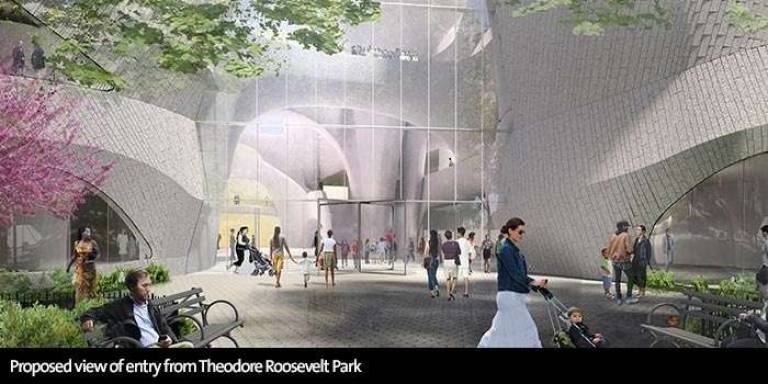Neighbors continue opposition to museum's “mini-Times Square”

By Madeleine Thompson
Upper West Siders who oppose the American Museum of Natural History’s expansion plans are not giving up, despite the project’s continued progress. After a year of rallies and hearings held by community groups as well as the museum, the AMNH’s proposed addition to its existing campus, the Gilder Center for Science, Education and Innovation, passed Community Board 7 and the Landmarks Preservation Committee with overwhelming support in October. But Community United to Protect Theodore Roosevelt Park, one of several groups that have organized in response to the Gilder Center, held a meeting last week to reaffirm their opposition and introduce their newly hired lawyer Michael Hiller.
Hiller is a prominent land use and preservation attorney who has defended the New York Public Library’s Stephen A. Schwarzman building against renovations that would have redone some of its historic architecture, and saved both a landmarked former church at 361 Central Park West and a rare mechanical clock tower in Lower Manhattan from conversion into luxury condos. Hiller told the roughly 60 attendees at last Thursday’s meeting that to beat the museum they would have to “channel your inner hippie, lock arms and walk the streets.”
“What you have to do is stand and fight,” Hiller said. It was one of 22 times the word “fight” was used that night. Hiller went on to criticize the treatment of public assets under Mayor Bill de Blasio, whom he blamed for their much higher rate of privatization.
Community United President Claudia DiSalvo and Vice President Bill Raudenbush also gave speeches intended to energize their neighbors. DiSalvo focused on the lasting impact the Gilder Center will have, saying that “future generations will view this decision … as a tragic, ahistorical fallacy.” Raudenbush assured attendees that, though it may seem wrong to oppose such a storied cultural institution, it was necessary. “When they build this Gilder Center, if they get away with it, most of [Theodore Roosevelt Park] will become pathways,” he said. “A mini-Times Square is going to be put up on the Upper West Side.”
DiSalvo thanked the other community groups that have formed since the natural history museum announced their Gilder Center proposal. Local organization against the museum began with Defenders of Teddy Roosevelt, which some members left to form Community United when they felt Defenders had taken too conciliatory an approach. Then some left that group to form the Alliance to Protect Theodore Roosevelt Park. Hiller alluded to the fractured organizational structure of the anti-Gilder Center movement, urging members to work out their issues privately. “Whatever differences you may have had with some other people who opposed this project, drop them,” he said. “The city drives wedges between these coalitions. You cannot diminish that leadership by infighting.”
Additional issues speakers had with the American Museum of Natural History included allegations that the museum is in too much debt to take on such a large project, that the Gilder Center’s design is far too grand and not conducive to carrying out the research and education goals it has set, and that the new entrance will flood the neighborhood with cars and pedestrians. The museum’s director of communications Roberto Lebron confirmed that, “like all large NYC cultural institutions,” the institution has taken on outstanding debt for various projects. He declined to provide the numerical value of that debt.
Topping the list of concerns, however, was the quarter-acre of park land near Columbus Avenue and 79th Street onto which the Gilder Center will encroach. Local park users so vocally decried the loss of trees and usable park space that the museum worked with some of them to reduce the number of trees being relocated from nine down to seven and cut the planned park square footage in half. The museum also collaborated with neighbors to redesign the park to preserve its private resting spots. For some, however, this will not suffice.
Despite allusions to the contrary at the meeting, Lebron said that no changes to the Gilder Center’s footprint had been made since before the project was approved by Community Board 7 and the Landmarks Preservation Commission. “In September we updated the square footage from 218,000 to approximately 235,000,” Lebron said. “That change did not impact the park and did not result in a change in the building height.”
Dates have not yet been set for environmental review process, but it is expected to begin in January. Hiller said he has multiple legal approaches in mind to slow and potentially stop the museum’s progress, adding that he sees “at least 14 different areas of significant environmental concern.” “Let’s stand together and let’s beat the crap out of them,” he said.
Madeleine Thompson can be reached at newsreporter@strausnews.com